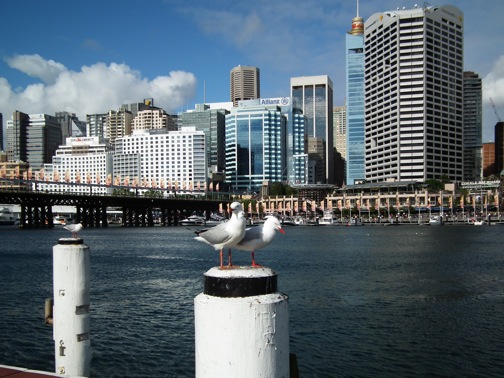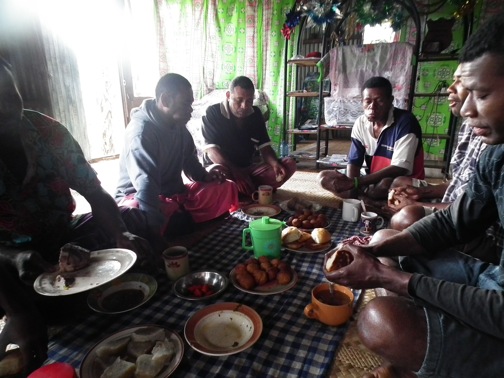Today I went to the Art Gallery of New South Wales to see the special exhibit called The Mad Square: Modernity in German Art 1910-37. Chronicling the modern art world of Germany in the decades leading up to the Second World War, the exhibit was comprehensive and revealing. In many ways, the quintessential experience of World War II was the Holocaust and, with Jews the main victims (although by no means the only victims), it seems quite fitting that the exhibit should be named after a work of art done by a German Jew in 1931.
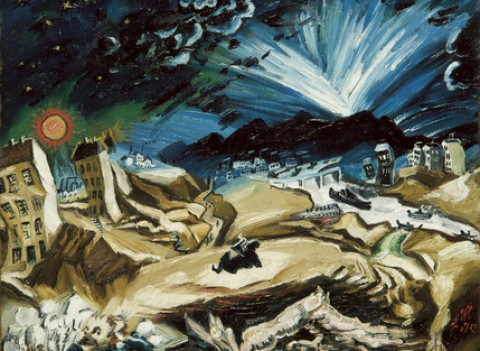 The first work that caught my eye was an earlier work by Ludwig Meidner called “Apocalyptic Landscape.” This work seemed to me to capture with foresight the future of Germany. The painting seems to show a land ravaged by war. The explosion in the background is particularly prophetic. Everything in the painting, from the barren, rocky land, to the teetering buildings, to the figure in the center huddled in a position of utter terror, seems to be a poignant portent of things to come. Although painted well before World War II became a reality, this painting, in many ways, seems to capture the Jewish experience.
The first work that caught my eye was an earlier work by Ludwig Meidner called “Apocalyptic Landscape.” This work seemed to me to capture with foresight the future of Germany. The painting seems to show a land ravaged by war. The explosion in the background is particularly prophetic. Everything in the painting, from the barren, rocky land, to the teetering buildings, to the figure in the center huddled in a position of utter terror, seems to be a poignant portent of things to come. Although painted well before World War II became a reality, this painting, in many ways, seems to capture the Jewish experience.
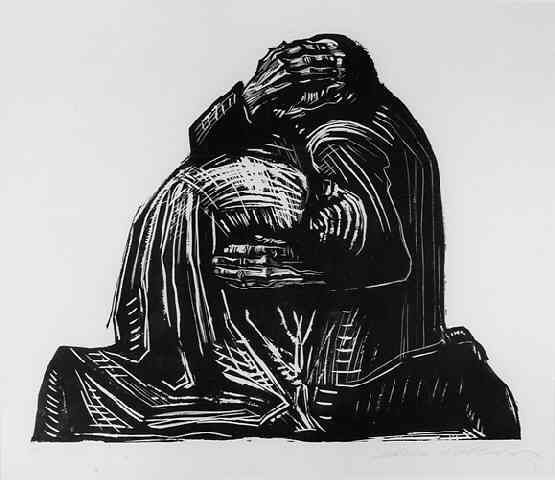 The next work that really spoke to me was Kathe Kollwitz’s “The Parents.” This one is not a painting. It is a woodblock print. Woodblock printing was unusual and radical for the time period, and Kollwitz used it as a political commentary. It symbolized her experience in World War I, having lost her son in that war. However, to me, the graphic portrayal of grief spoke to me of what Jewish parents felt as they watched their children dying in the concentration camps. It speaks to me of what all Jews feel when we contemplate the Holocaust – the mind-numbing grief that comes with the loss of millions of family members.
The next work that really spoke to me was Kathe Kollwitz’s “The Parents.” This one is not a painting. It is a woodblock print. Woodblock printing was unusual and radical for the time period, and Kollwitz used it as a political commentary. It symbolized her experience in World War I, having lost her son in that war. However, to me, the graphic portrayal of grief spoke to me of what Jewish parents felt as they watched their children dying in the concentration camps. It speaks to me of what all Jews feel when we contemplate the Holocaust – the mind-numbing grief that comes with the loss of millions of family members.
 Toward the end of the exhibit, the works came closer and closer to World War II. There were numerous works by John Heartfield, whose blatant anti-Hitler and anti-Nazi images are incredibly graphic. Most of those on exhibit in the museum are actually too explicit to show images of on TravelingRabbi! Yet, they are incredibly true to life. Before the Nazis even began their extermination of their “enemies,” Heartfield managed to show just the kind of tragedies that were going to be inflicted by them. He was probably thought an extremist at the time, but now I think he must have been incredibly wise.
Toward the end of the exhibit, the works came closer and closer to World War II. There were numerous works by John Heartfield, whose blatant anti-Hitler and anti-Nazi images are incredibly graphic. Most of those on exhibit in the museum are actually too explicit to show images of on TravelingRabbi! Yet, they are incredibly true to life. Before the Nazis even began their extermination of their “enemies,” Heartfield managed to show just the kind of tragedies that were going to be inflicted by them. He was probably thought an extremist at the time, but now I think he must have been incredibly wise.
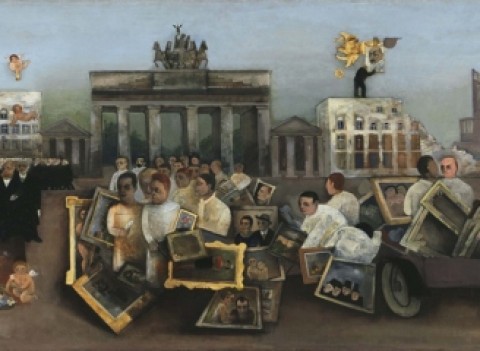 Finally, there was Felix Nussbaum’s famous work, “The Mad Square,” the title piece for the exhibition. How fitting that a German Jew who died in the Holocaust should have one of his works the main piece in this exhibit. This work shows the craziness that overtook Germany in the 1930s. The crowd that converges on Berlin’s famous Pariser Platz is compounded by the people shown in the piled-up paintings and portraits. It reflects the high level of edginess in the entire exhibit, the anxiety about societal moves into modernity and the effects it had on German politics.
Finally, there was Felix Nussbaum’s famous work, “The Mad Square,” the title piece for the exhibition. How fitting that a German Jew who died in the Holocaust should have one of his works the main piece in this exhibit. This work shows the craziness that overtook Germany in the 1930s. The crowd that converges on Berlin’s famous Pariser Platz is compounded by the people shown in the piled-up paintings and portraits. It reflects the high level of edginess in the entire exhibit, the anxiety about societal moves into modernity and the effects it had on German politics.
The overall exhibit shows many aspects of German society that caused anxiety and discontent among the German people. One of the most prominently featured themes was that of women’s internal conflicts with the modernity thrust upon them. The movement of women from a role as primarily homemakers into being expected to join the wage workforce parallels the Jewish Reform Movement’s progressive push to be accepted by general German society. Just as German society was conflicted when its women began to change their identity, so too was there anxiety associated with the Jewish move from the shtetl out into the modern world. But, of course, Jews made a much better scapegoat for poverty and change-fueled anxiety than women. This journey in German society was very aptly captured and revealed in this moving art exhibit.
Read More



